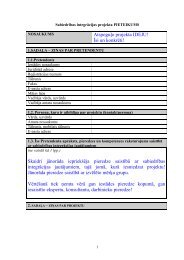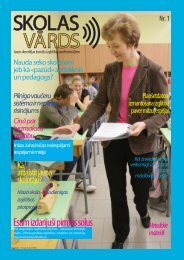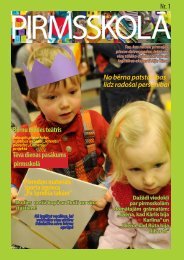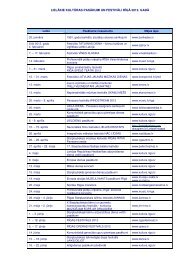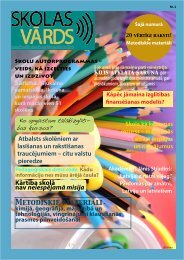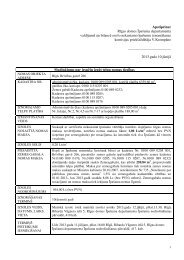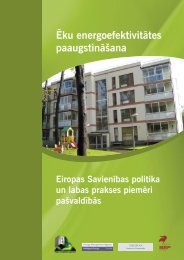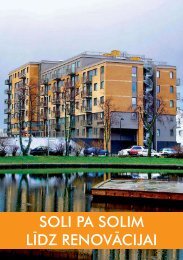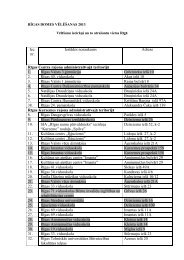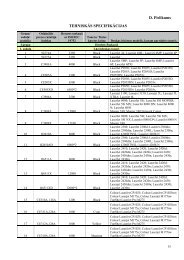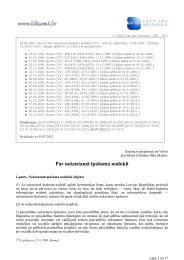Riga - European Capital of Culture 2014 candidate
Riga - European Capital of Culture 2014 candidate
Riga - European Capital of Culture 2014 candidate
- No tags were found...
You also want an ePaper? Increase the reach of your titles
YUMPU automatically turns print PDFs into web optimized ePapers that Google loves.
oad mapThe greater part <strong>of</strong> mankind lives in cities. The conditions createdby the urban environment form the dense weave <strong>of</strong> everydayrituals and participate in forming the signification <strong>of</strong> privateand public space. A city is not only made up <strong>of</strong> buildings andcarriageways, but rather by containers <strong>of</strong> meaning, flows <strong>of</strong>information, language grids and vectors <strong>of</strong> varied pressure.Cities are like living organisms that can grow dynamicallyand aggressively, as well as being helpless, confused anddiminishing. They can be led by the dynamics <strong>of</strong> the explosivedevelopment <strong>of</strong> ‘generic cities’ (Rem Koolhaas) groundedin the pragmatism <strong>of</strong> capitalism. Or, it might be the globalcity defined by Saskia Sassen, in which the local is found inconstant interaction with the global. It may be assumed thata city grows by itself.The language <strong>of</strong> a city is determined by the urban rituals, navigationalsigns and gestures that are integrated and brought to lifein the complex social network. Cities create a multitude <strong>of</strong> platforms,<strong>of</strong>fering a common living space for individuals <strong>of</strong> differentcultures and identities, activating the transformation <strong>of</strong> the privateand public space, catalysing the collision <strong>of</strong> differing positionsand nursing the spirit <strong>of</strong> resistance.Just as in the recipe <strong>of</strong> a refined dish meal, a multitude <strong>of</strong> ingredientsblend together in the language <strong>of</strong> the city, the proportiondetermining each city’s unique flavour. The “mental” cartography<strong>of</strong> <strong>Riga</strong> is formed by the historical architecture <strong>of</strong> the Old Town,the Jugendstil <strong>of</strong> Albert Street and the pavilions <strong>of</strong> the CentralMarket - the former zeppelin hangars. It is also formed by the urbanarchaeology <strong>of</strong> Soviet times, the so-called “high-rise areas” <strong>of</strong>the city, allotments in the city centre, the annual trek to Bolderājaby the members <strong>of</strong> the Unprecedented Sensations RestorationWorkshop, the Art Day demonstrations in the station tunnels, thecreative dynamics <strong>of</strong> Andrejsala and Spīķeri, the silhouettes <strong>of</strong>the Sun Stone building and the Ministry <strong>of</strong> Agriculture, the 9 th Maygatherings by the Victory Monument and singing people returningfrom the Song Celebration on the night-time trams.“Road Map” is an alternative plan, which allows everyone to findhis or her own <strong>Riga</strong>, hidden under the city facades and found inthe minds <strong>of</strong> people – a <strong>Riga</strong> that has passed, forgotten due tonew historical, social and political grounds. “Road map” is a planand at the same time a detour from the usual sights observed bytourists. The road map idea is the integration <strong>of</strong> inhabitants in thecreation <strong>of</strong> new routes that would not just be roads in the physicaland direct sense. They would reveal and create a new circulationsystem for the city. “Road Map” incorporates short-termand long-term objectives. The short-term objective is to open uporiginal city locations for cooperation and accessibility, neighbourhoodstories, memories and events. The long-term objectiveis to develop <strong>Riga</strong> as a city with many active centres, each onestanding out with its unique character and originality.“Road Map” invites local inhabitants, city researchers and gueststo seek their own <strong>Riga</strong>, not by confronting the city centre with itssuburbs, but trying to find and highlight the specific local featuresand unique atmosphere <strong>of</strong> each place.At times the inhabitants <strong>of</strong> the suburbs live a completely parallellife to the city centre. These are people for whom going to the citycentre once a week is to “go into town”, whose daily lives are spentmoving around within the borders <strong>of</strong> catchment areas, from workto the shop and from the shop back home, and whose eveningsare spent working on the allotment or chatting to the neighboursin the yard. The suburbs are also occupied by the inhabitants <strong>of</strong>the so-called high-rise areas, who crowd into the public transportshelters to travel to the city centre and return to their homes late inthe evening, and therefore never finding out who lives in the nextdoor apartment.“Road Map” tries to address the inhabitants <strong>of</strong> the suburbs andoutskirts <strong>of</strong> <strong>Riga</strong>, surprising them like a force majeure in their familiarpaths from the shop to their home, and by integrating intothe various forms <strong>of</strong> the area’s infrastructure, trying to address thesection <strong>of</strong> society that might never wander into an art gallery ormuseum or attend any other alternative cultural event, and involvethem in the processes <strong>of</strong> culture.Marginal territories are drawn into the centre <strong>of</strong> attention andthe anthropological texture <strong>of</strong> the local environment becomes asource <strong>of</strong> inspiration for well-known directors. Instead <strong>of</strong> “Hamlet”,the “Tales <strong>of</strong> Bolderāja” are produced, the inhabitants <strong>of</strong> high-riseblocks unnoticed until now, become the heroes <strong>of</strong> books and theinhabitants <strong>of</strong> buildings are invited to find out more about the differentcultural traditions <strong>of</strong> their neighbours and discover a newdimension <strong>of</strong> experiences. Road map invites you to find out moreabout each other and get to know each other better. Torņakalnsgoes visiting Ķengarags and the Centre visits Purvciems.Guests to the city who wish to look at <strong>Riga</strong> from another angle arealso invited to head for the suburbs, to see what happens outsidethe representative part <strong>of</strong> the city centre and to get to know its‘secret places’. It is an invitation to go on a psycho-geographicaljourney, similar to the flâneur formulated by Walter Benjamin, succumbingto seemingly aimless wandering around the city or usingthe dérive method favoured by situationists, which describes thespontaneous propulsion through various zones <strong>of</strong> the city.“Road Map” in these journeys serves as a guide, as a type <strong>of</strong>compass that is pointed towards a different <strong>Riga</strong> each time.These might be excursions that illuminate the different segments<strong>of</strong> <strong>Riga</strong>’s history – the Soviet period in <strong>Riga</strong>, communal apartments,interiors, air raid shelters, the industrial heritage <strong>of</strong> <strong>Riga</strong>,old factories, specific architecture and manufacturing facilities,Hebrew <strong>Riga</strong>, a city that has arranged itself around more than 40islands, Bohemian <strong>Riga</strong>, design city, a cyclist’s <strong>Riga</strong>, etc. “RoadMap” not only invites you to get to know previously little knownparts <strong>of</strong> the town, but also to briefly open the door to rooms wherepeople are not usually allowed, such as water towers, weatherstations, the backstage <strong>of</strong> theatres, etc.Poetry, music and city noises that transform into the art <strong>of</strong> sounds,literature that allows you to take on the role <strong>of</strong> a book characterand see the city with different eyes, are all instruments used forthe exploration <strong>of</strong> the city and the search for unusual viewpoints.Local libraries, interest-related educational institutions, local culturalcentres and schools wake up as vital epicentres for culture.New creative platforms are also created, which for a time come tolife as testing laboratories in various city quarters and, with the cooperation<strong>of</strong> artists, actors and musicians, together with the localinhabitants, create a new <strong>Riga</strong> – a city whose main and invincibleforce will be culture.74 75



